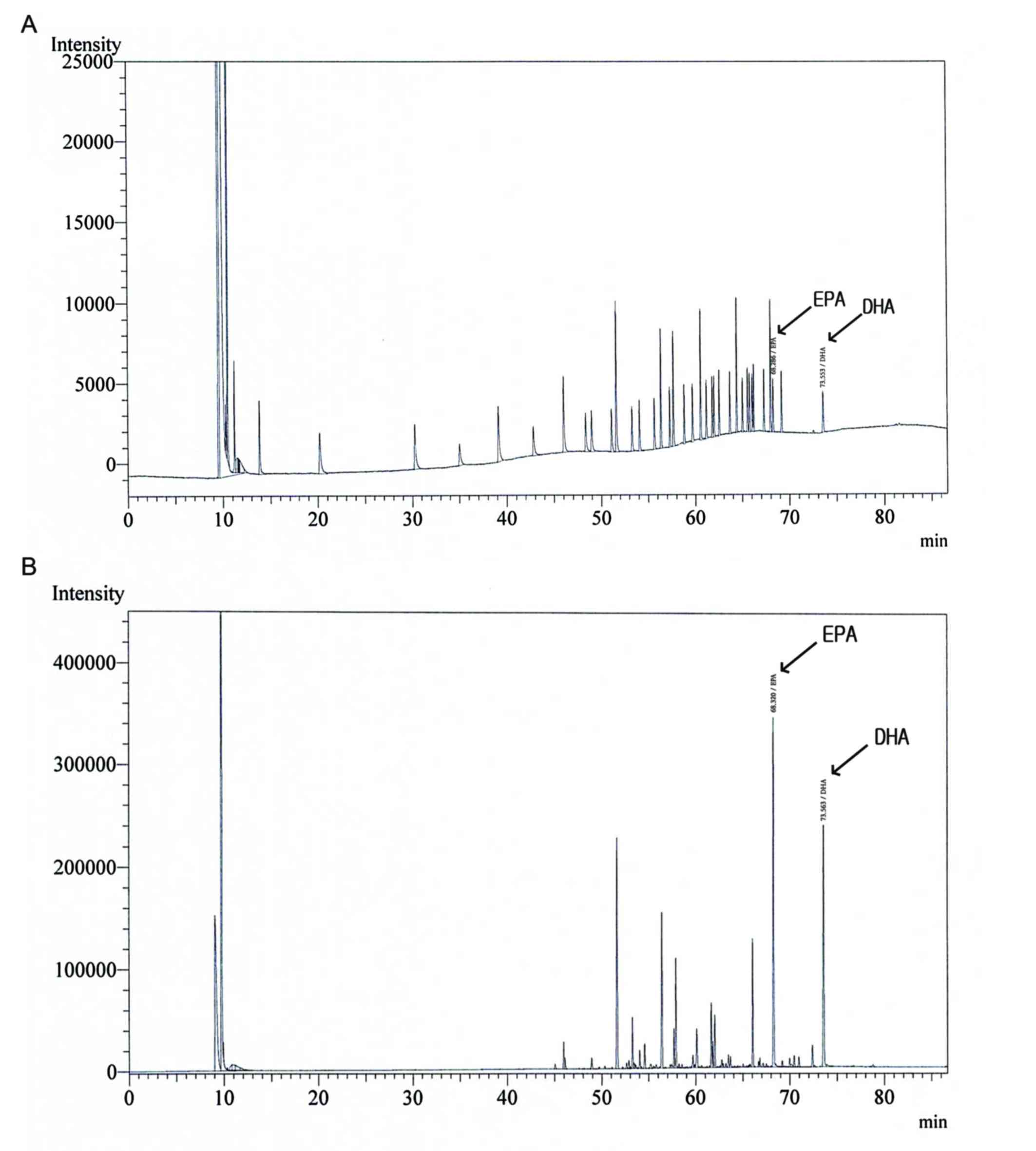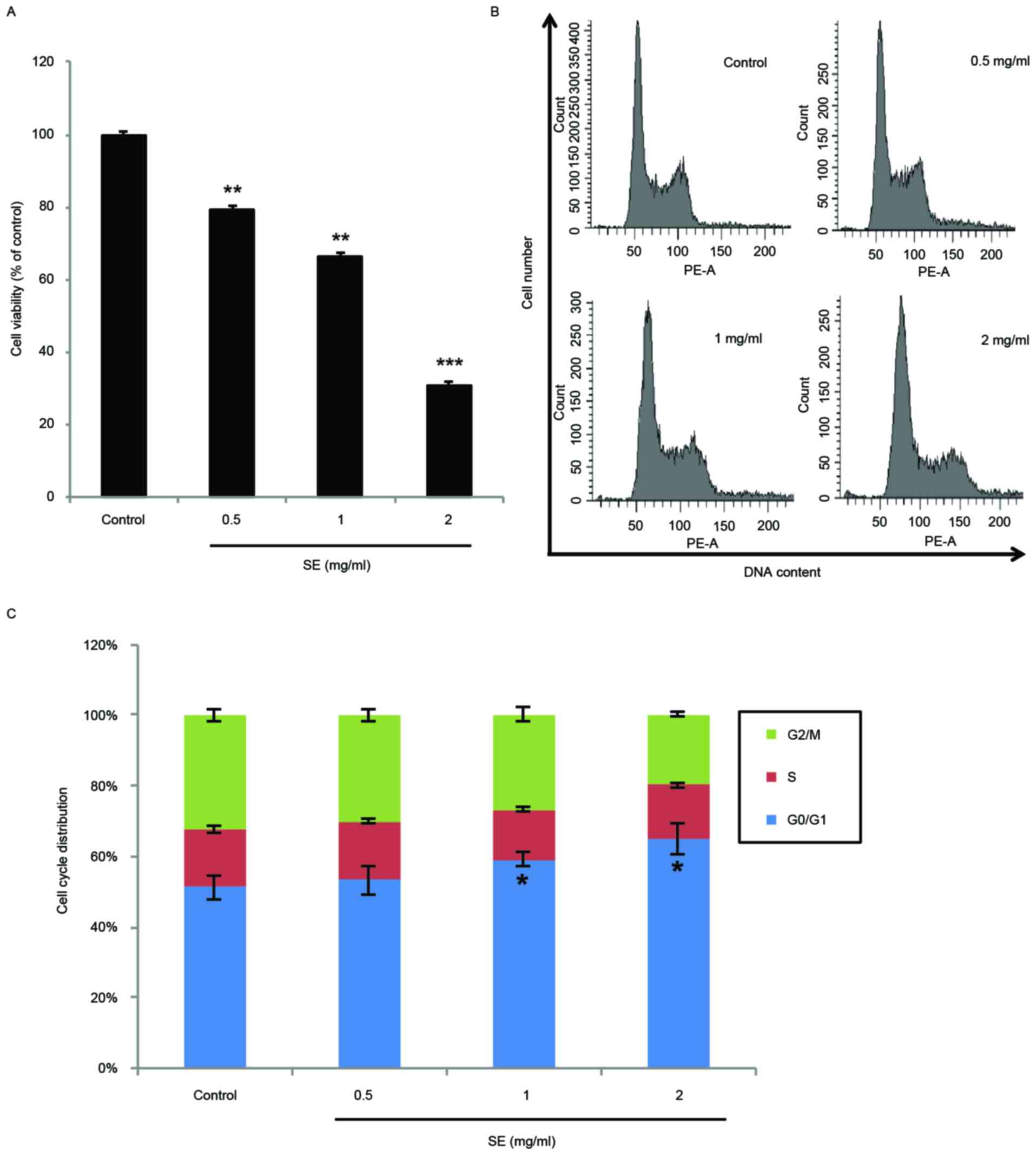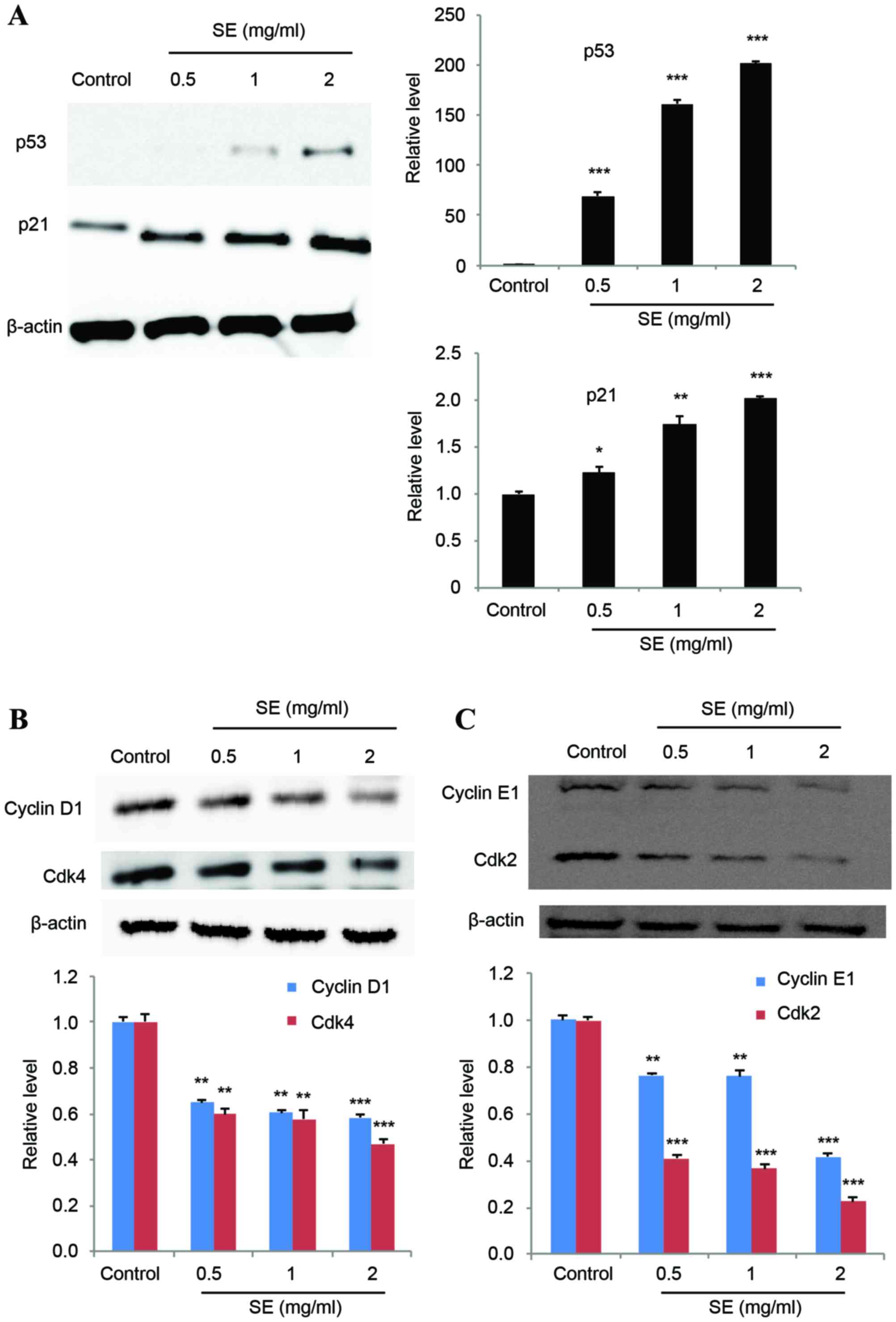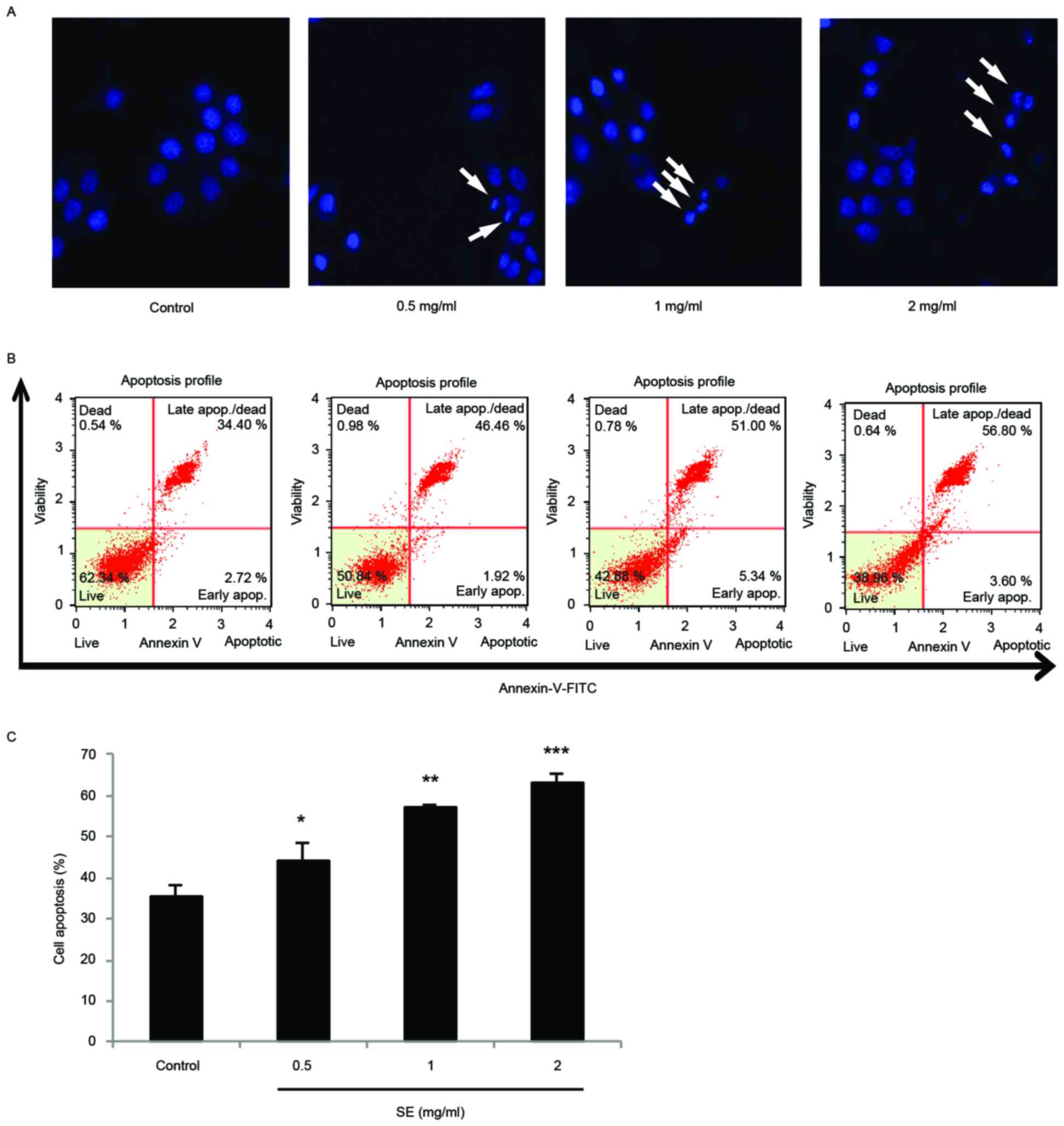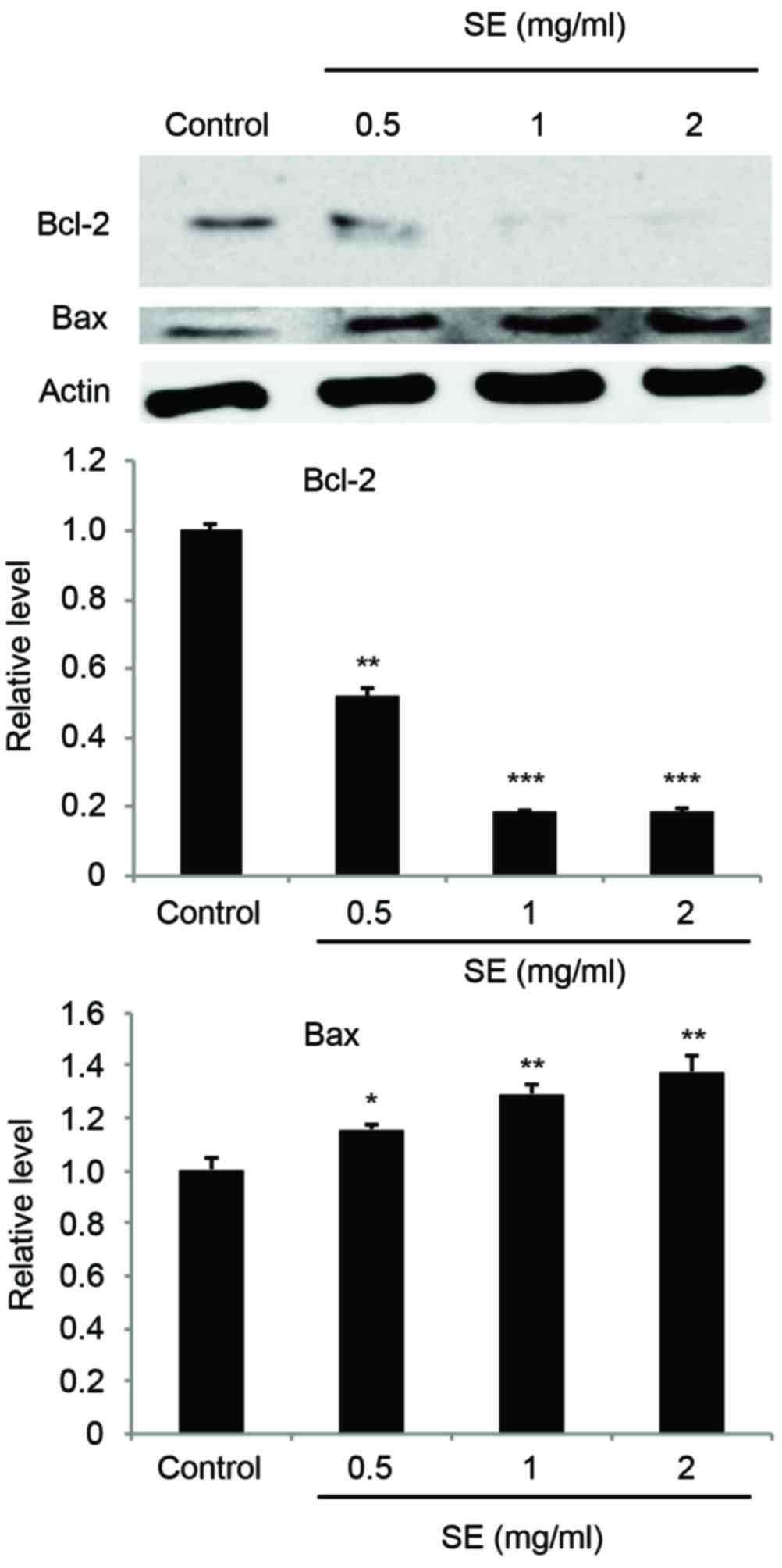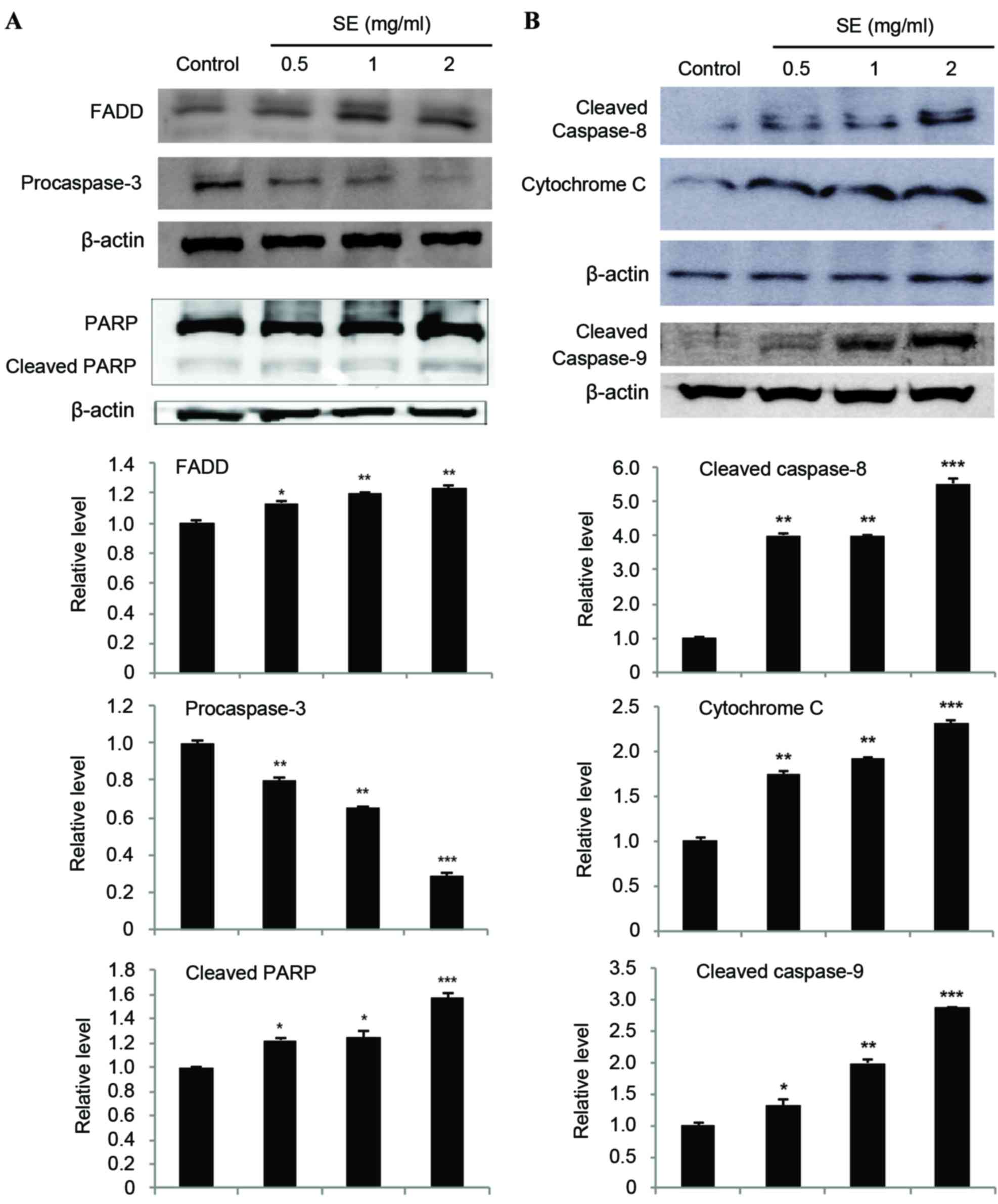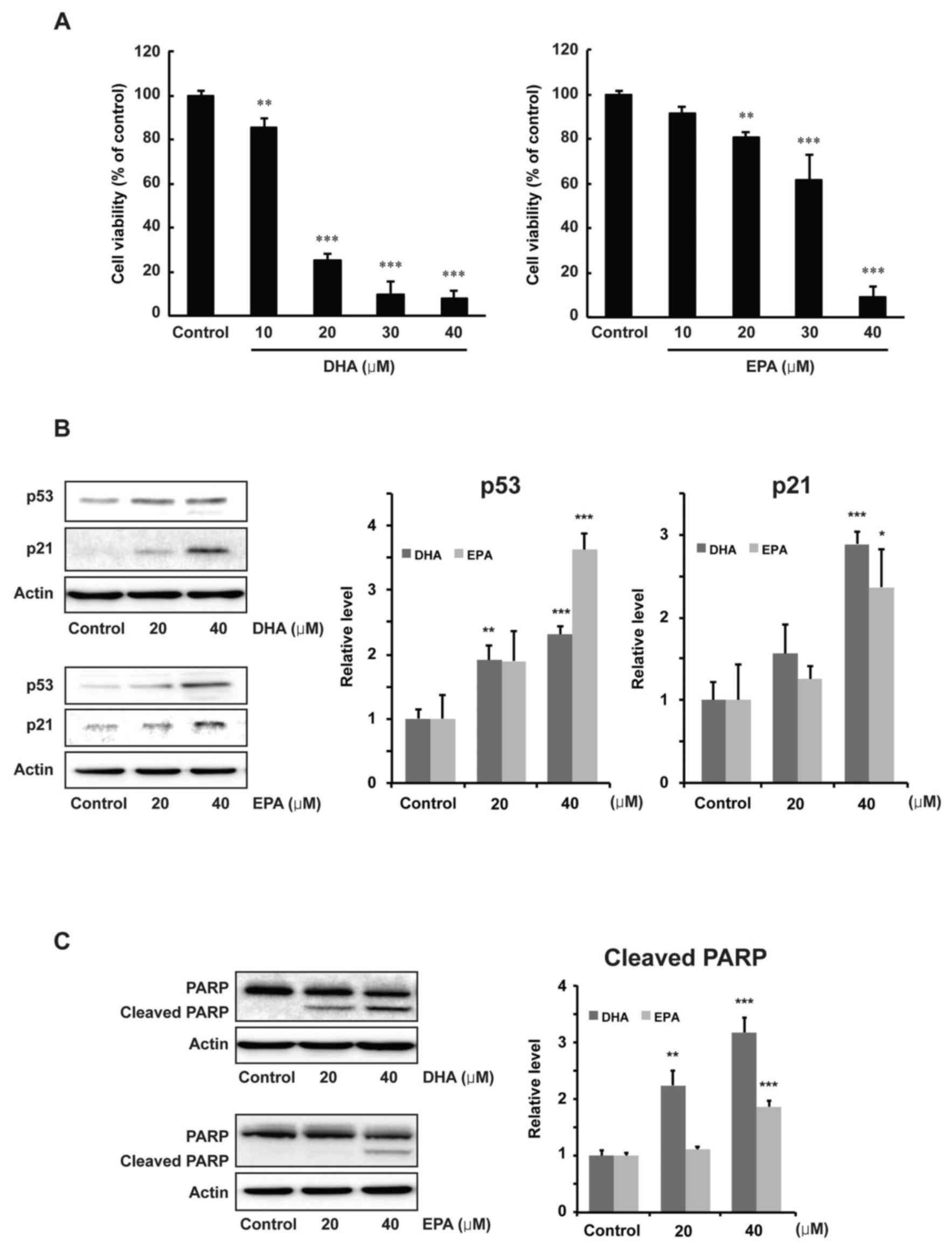|
1
|
Xiao PG: Atlas of Chinese Herbs. The
Commercial Press Ltd.; Hong Kong: 7. pp. 2021990
|
|
2
|
Nam M, Lee C, Moon TS and Huh MK: Genetic
diversity and population structure of the scallop patinopecten
yessoensis in Korea, China and Japan by random amplified
polymorphic DNA markers. J Life Sci. 22:466–471. 2012. View Article : Google Scholar
|
|
3
|
Saad ED: Endpoints in advanced breast
cancer: Methodological aspects & clinical implications. Indian
J Med Res. 134:413–418. 2011.PubMed/NCBI
|
|
4
|
Siegel R, Ma J, Zou Z and Jemal A: Cancer
statistics, 2014. CA Cancer J Clin. 64:9–29. 2014. View Article : Google Scholar : PubMed/NCBI
|
|
5
|
Tsao AS, Kim ES and Hong WK:
Chemoprevention of cancer. CA Cancer J Clin. 54:150–180. 2004.
View Article : Google Scholar : PubMed/NCBI
|
|
6
|
Hunter T and Pines J: Cyclins and cancer
II Cyclin D and CDK inhibitors come of age. Cell. 79:573–582. 1994.
View Article : Google Scholar : PubMed/NCBI
|
|
7
|
Harper JW and Elledge SJ: CDK inhibitors
in development and cancer. Curr Opin Genet Dev. 6:56–64. 1996.
View Article : Google Scholar : PubMed/NCBI
|
|
8
|
Sherr CJ: Cancer cell cycles. Science.
274:1672–1677. 1996. View Article : Google Scholar : PubMed/NCBI
|
|
9
|
Gartel AL and Tyner AL: The role of the
cyclin-dependent kinase inhibitor p21 in apoptosis. Mol Cancer
Ther. 1:639–649. 2002.PubMed/NCBI
|
|
10
|
Meek DW: The p53 response to DNA damage.
DNA Repair (Amst). 3:1049–1056. 2004. View Article : Google Scholar : PubMed/NCBI
|
|
11
|
Weng MS, Ho YS and Lin JK: Chrysin induces
G1 phase cell cycle arrest in C6 glioma cells through inducing
p21Waf1/Cip1 expression: Involvement of p38 mitogen-activated
protein kinase. Biochem Pharmacol. 69:1815–1827. 2005. View Article : Google Scholar : PubMed/NCBI
|
|
12
|
Muppidi J, Porter M and Siegel RM:
Measurement of apoptosis and other forms of cell death. Curr Protoc
Immunol. 3:3–17. 2004.
|
|
13
|
Evan GI and Vousden KH: Proliferation,
cell cycle and apoptosis in cancer. Nature. 411:342–348. 2001.
View Article : Google Scholar : PubMed/NCBI
|
|
14
|
MacKenzie SH and Clark AC: Targeting cell
death in tumors by activating caspases. Curr Cancer Drug Targets.
8:98–109. 2008. View Article : Google Scholar : PubMed/NCBI
|
|
15
|
Repicky A, Jantova S and Milata V: Signal
pathways of cell proliferation and death as targets of potential
chemotherapeutics. Ceska Slov Farm. 57:4–10. 2008.(In Slovak).
PubMed/NCBI
|
|
16
|
Ireland CM, Copp BR, Foster MP, et al:
Biomedical potential of marine natural productsPharmaceutical and
bioactive natural products. Attaway DH and Zaborsky OR: Springer
US; New York, USA: 1. pp. 1–43. 1993, View Article : Google Scholar
|
|
17
|
Lv S, Gao J, Liu T, Zhu J, Xu J, Song L,
Liang J and Yu R: Purification and partial characterization of a
new antitumor protein from Tegillarca granosa. Mar Drugs.
13:1466–1480. 2015. View Article : Google Scholar : PubMed/NCBI
|
|
18
|
Sasaki T, Uchida H, Uchida NA, et al:
Antitumor activity and immunomodulatory effect of glycoprotein
fraction from scallop Patinopecten yessoensis. Nippon Suisan
Gakkaishi. 53:267–272. 1987. View Article : Google Scholar
|
|
19
|
Zhang H, Wang K, Lin G and Zhao Z:
Antitumor mechanisms of S-allyl mercaptocysteine for breast cancer
therapy. BMC Complement Altern Med. 14:2702014. View Article : Google Scholar : PubMed/NCBI
|
|
20
|
Vermeulen K, Van Bockstaele DR and
Berneman ZN: The cell cycle: A review of regulation, deregulation
and therapeutic targets in cancer. Cell Prolif. 36:131–149. 2003.
View Article : Google Scholar : PubMed/NCBI
|
|
21
|
Schwartz GK and Shah MA: Targeting the
cell cycle: A new approach to cancer therapy. J Clin Oncol.
23:9408–9421. 2005. View Article : Google Scholar : PubMed/NCBI
|
|
22
|
Nagle AA, Gan FF, Jones G, So CL, Wells G
and Chew EH: Induction of tumor cell death through targeting
tubulin and evoking dysregulation of cell cycle regulatory proteins
by multifunctional cinnamaldehydes. PLoS One. 7:e501252012.
View Article : Google Scholar : PubMed/NCBI
|
|
23
|
Bellamy CO: p53 and apoptosis. Br Med
Bull. 53:522–538. 1997. View Article : Google Scholar : PubMed/NCBI
|
|
24
|
Levine AJ: p53, the cellular gatekeeper
for growth and division. Cell. 88:323–331. 1997. View Article : Google Scholar : PubMed/NCBI
|
|
25
|
Pucci B, Kasten M and Giordano A: Cell
cycle and apoptosis. Neoplasia. 2:291–299. 2000. View Article : Google Scholar : PubMed/NCBI
|
|
26
|
Harris SL and Levine AJ: The p53 pathway:
Positive and negative feedback loops. Oncogene. 24:2899–2908. 2005.
View Article : Google Scholar : PubMed/NCBI
|
|
27
|
Didenko VV, Wang X, Yang L and Hornsby PJ:
Expression of p21(WAF1/CIP1/SDI1) and p53 in apoptotic cells in the
adrenal cortex and induction by ischemia/reperfusion injury. J Clin
Invest. 97:1723–1731. 1996. View Article : Google Scholar : PubMed/NCBI
|
|
28
|
Yang L, Zhang HW, Hu R, Yang Y, Qi Q, Lu
N, Liu W, Chu YY, You QD and Guo QL: Wogonin induces G1 phase
arrest through inhibiting CDK4 and cyclin D1 concomitant with an
elevation in p21Cip1 in human cervical carcinoma HeLa cells.
Biochem Cell Biol. 87:933–942. 2009. View
Article : Google Scholar : PubMed/NCBI
|
|
29
|
Zorn JA, Wolan DW, Agard NJ and Wells JA:
Fibrils colocalize caspase-3 with procaspase-3 to foster
maturation. J Biol Chem. 287:33781–33795. 2012. View Article : Google Scholar : PubMed/NCBI
|
|
30
|
Donepudi M and Grütter MG: Structure and
zymogen activation of caspases. Biophys Chem 101–102. 145–153.
2002. View Article : Google Scholar
|
|
31
|
Stennicke HR and Salvesen GS: Caspases.
Controlling intracellular signals by protease zymogen activation.
Biochim Biophys Acta. 1477:299–306. 2000. View Article : Google Scholar : PubMed/NCBI
|
|
32
|
Gray DC, Mahrus S and Wells JA: Activation
of specific apoptotic caspases with an engineered small
molecule-activated protease. Cell. 142:637–646. 2010. View Article : Google Scholar : PubMed/NCBI
|
|
33
|
Putt KS, Chen GW, Pearson JM, Sandhorst
JS, Hoagland MS, Kwon JT, Hwang SK, Jin H, Churchwell MI, Cho MH,
et al: Small-molecule activation of procaspase-3 to caspase-3 as a
personalized anticancer strategy. Nat Chem Biol. 2:543–550. 2006.
View Article : Google Scholar : PubMed/NCBI
|
|
34
|
Fulda S and Debatin KM: Extrinsic versus
intrinsic apoptosis pathways in anticancer chemotherapy. Oncogene.
25:4798–4811. 2006. View Article : Google Scholar : PubMed/NCBI
|
|
35
|
Salvesen GS and Riedl SJ: Caspase
mechanisms. Adv Exp Med Biol. 615:13–23. 2008. View Article : Google Scholar : PubMed/NCBI
|
|
36
|
McIlwain DR, Berger T and Mak TW: Caspase
functions in cell death and disease. Cold Spring Harb Perspect
Biol. 5:a0086562013. View Article : Google Scholar : PubMed/NCBI
|
|
37
|
Kroemer G and Reed JC: Mitochondrial
control of cell death. Nat Med. 6:513–519. 2000. View Article : Google Scholar : PubMed/NCBI
|
|
38
|
Gross A, McDonnell JM and Korsmeyer SJ:
Bcl-2 family members and the mitochondria in apoptosis. Genes Dev.
13:1899–1911. 1999. View Article : Google Scholar : PubMed/NCBI
|
|
39
|
Li H, Wang LJ, Qiu GF, Yu JQ, Liang SC and
Hu XM: Apoptosis of Hela cells induced by extract from
Cremanthodium humile. Food Chem Toxicol. 45:2040–2046. 2007.
View Article : Google Scholar : PubMed/NCBI
|
|
40
|
Elmore S: Apoptosis: A review of
programmed cell death. Toxicol Pathol. 35:495–516. 2007. View Article : Google Scholar : PubMed/NCBI
|
|
41
|
Nagata S: Apoptosis by death factor. Cell.
88:355–365. 1997. View Article : Google Scholar : PubMed/NCBI
|
|
42
|
Schwartsmann G, da Rocha A Brondani,
Berlinck RG and Jimeno J: Marine organisms as a source of new
anticancer agents. Lancet Oncol. 2:221–225. 2001. View Article : Google Scholar : PubMed/NCBI
|
|
43
|
Mitsiades CS, Ocio EM, Pandiella A, Maiso
P, Gajate C, Garayoa M, Vilanova D, Montero JC, Mitsiades N,
McMullan CJ, et al: Aplidin, a marine organism-derived compound
with potent antimyeloma activity in vitro and in vivo. Cancer Res.
68:5216–5225. 2008. View Article : Google Scholar : PubMed/NCBI
|
|
44
|
Suarez-Jimenez GM, Burgos-Hernandez A and
Ezquerra-Brauer JM: Bioactive peptides and depsipeptides with
anticancer potential: Sources from marine animals. Mar Drugs.
10:963–986. 2012. View Article : Google Scholar : PubMed/NCBI
|
|
45
|
Chapkin RS, Seo J, McMurray DN and Lupton
JR: Mechanisms by which docosahexaenoic acid and related fatty
acids reduce colon cancer risk and inflammatory disorders of the
intestine. Chem Phys Lipids. 153:14–23. 2008. View Article : Google Scholar : PubMed/NCBI
|
|
46
|
Fukui M, Kang KS, Okada K and Zhu BT: EPA,
an omega-3 fatty acid, induces apoptosis in human pancreatic cancer
cells: Role of ROS accumulation, caspase-8 activation, and
autophagy induction. J Cell Biochem. 114:192–203. 2013. View Article : Google Scholar : PubMed/NCBI
|
|
47
|
Maleek MI: Omega-3 fatty acids decrease
the proliferation of Rhabdomyosarcoma (RD) and Vero cell lines. J
Cancer Sci Ther. 5:85–88. 2013. View Article : Google Scholar
|
|
48
|
Park JM, Kwon SH, Han YM, Hahm KB and Kim
EH: Omega-3 polyunsaturated fatty acids as potential
chemopreventive agent for gastrointestinal cancer. J Cancer Prev.
18:201–208. 2013. View Article : Google Scholar : PubMed/NCBI
|
|
49
|
Yang P, Cartwright C, Chan D, Ding J,
Felix E, Pan Y, Pang J, Rhea P, Block K, Fischer SM, et al:
Anticancer activity of fish oils against human lung cancer is
associated with changes in formation of PGE2 and PGE3 and
alteration of Akt phosphorylation. Mol Carcinog. 53:566–577. 2014.
View Article : Google Scholar : PubMed/NCBI
|
|
50
|
Kato T, Hancock RL, Mohammadpour H,
McGregor B, Manalo P, Khaiboullina S, Hall MR, Pardini L and
Pardini RS: Influence of omega-3 fatty acids on the growth of human
colon carcinoma in nude mice. Cancer Lett. 187:169–177. 2002.
View Article : Google Scholar : PubMed/NCBI
|
|
51
|
Wu M, Harvey KA, Ruzmetov N, Welch ZR,
Sech L, Jackson K, Stillwell W, Zaloga GP and Siddiqui RA: Omega-3
polyunsaturated fatty acids attenuate breast cancer growth through
activation of a neutral sphingomyelinase-mediated pathway. Int J
Cancer. 117:340–348. 2005. View Article : Google Scholar : PubMed/NCBI
|
|
52
|
Shaikh IA, Brown I, Schofield AC, Wahle KW
and Heys SD: Docosahexaenoic acid enhances the efficacy of
docetaxel in prostate cancer cells by modulation of apoptosis: The
role of genes associated with the NF-kappaB pathway. Prostate.
68:1635–1646. 2008. View Article : Google Scholar : PubMed/NCBI
|
|
53
|
Hawcroft G, Volpato M, Marston G, Ingram
N, Perry SL, Cockbain AJ, Race AD, Munarini A, Belluzzi A, Loadman
PM, et al: The omega-3 polyunsaturated fatty acid eicosapentaenoic
acid inhibits mouse MC-26 colorectal cancer cell liver metastasis
via inhibition of PGE2-dependent cell motility. Br J Pharmacol.
166:1724–1737. 2012. View Article : Google Scholar : PubMed/NCBI
|



